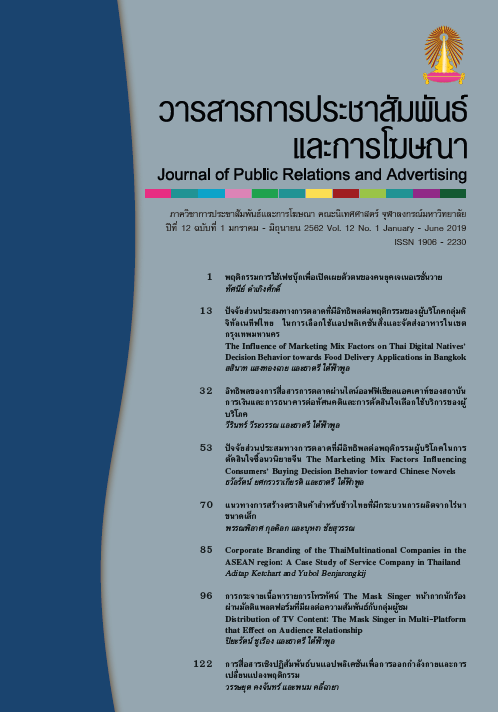Distribution of TV Content: The Mask Singer in Multi-Platform that Effect on Audience Relationship
Main Article Content
Abstract
The objective of this research is to study the distribution, brand, product placement of The Mask Singer’s TV content and the effectiveness to audience relationship by the qualitative textual research analysis and focus group discussion of the audiences who watch TV content continuously and discontinuously. In the result, we found that the distribution of The Mask Singer’s TV content has two formats. First TV content broadcasting is limited on television platform. Second, TV content broadcasting is unlimited on online and application platforms. The content of online and application platforms are changed to each of platforms, but it remains same story line. The formats of brand or product placement in The Mask Singer’s TV content consist of visual type and Audio and visual type.
The effectiveness of distribution of TV content is audiences receive TV content form multi-platform in anytime and anywhere. Although the audiences watch TV content unintentionally, but they have positive attitudes towards accession of TV content form multi-platform. The effectiveness of brand or product placement of TV content is creation brand awareness. All of audiences know that brand or product placement is another kind of sponsorship. In the effectiveness of audience relationship result, audiences are not attracted to formats of brand or product placement. The number of audiences who are acknowledge of the brand image and those who are not different. However, the audiences will satisfy if brand or product placement do not show both audio and visual format because the audiences are annoyed.
Article Details
References
คนดูทีวีน้อยกว่าสตรีมมิ่ง. (2015). วันที่เข้าถึงข้อมูล 15 มกราคม 2561, แหล่งที่มา https://shows.voicetv.co.th/voice-market/157959.html
ชยพล สุทธิโยธิน. (2550). แนวคิดเกี่ยวกับการสร้างสรรค์รายการโทรทัศน์. (พิมพ์ครั้งที่ 2). นนทบุรี: สำนักพิมพ์มหาวิทยาลัยสุโขทัยธรรมาธิราช.
รัตติยา อังกุลานนท์. (2557). ชูทีวี'มัลติแพลตฟอร์ม'ตอบโจทย์สื่อยุคดิจิทัล. วันที่เข้าถึงข้อมูล 15 มกราคม 2561, แหล่งที่มา http://www.bangkokbiznews.com/news/detail/561916
รัตติยา อังกุลานนท์. (2559). ยุทธ์'บีบีทีวี นิวมีเดีย'บูมดิจิทัลแพลตฟอร์ม'ช่อง7'. วันที่เข้าถึงข้อมูล 15 มกราคม 2561, แหล่งที่มา http://www.bangkokbiznews.com/news/detail/703198
รัตติยา อังกุลานนท์. (2560). วัดเรทติ้ง'มัลติสกรีน' ตามหาผู้ชมทิ้งจอทีวี. วันที่เข้าถึงข้อมูล 15 มกราคม 2561, แหล่งที่มา http://www.bangkokbiznews.com/blog/detail/641512
ทีวีแก้โจทย์หินดึงคนดูคืนจอ “3-7-เวิร์คพอยท์” เพิ่มดีกรีบุกออนไลน์. (2560, 10 สิงหาคม). วันที่เข้าถึงข้อมูล 15 มกราคม 2561, แหล่งที่มา https://www.prachachat.net/marketing/news-20224
ละคร งงเด้ ! The Mask Singer เรตติ้งแซงขึ้น 10 ทวิตเตอร์ อันดับ 2 ของโลก. (2560, 10 มีนาคม). วันที่ เข้าถึงข้อมูล 15 มกราคม 2561, แหล่งที่มา http://positioningmag.com/1118995
แกรมมี่ตั้งทีมผลิตคอนเทนต์ เพิ่มเรตติ้งดันรายได้800ล้าน. (2559, 8 มิถุนายน). วันที่เข้าถึงข้อมูล 15 มกราคม 2561, แหล่งที่มา http://www.thansettakij.com/content/59153
ภาษาอังกฤษ
Wanee L. (2560). สงครามเรตติ้งชิงเงินโฆษณา. วันที่เข้าถึงข้อมูล 15 มกราคม 2561, แหล่งที่มา https://news.voicetv.co.th/business/472902.html
Chris Baumannac, Hamin Haminb & Amy Chongc. (2015). The role of brand exposure and experience on brand recall.. Journal of Retailing and Consumer Services. 23, 21-31.
Competition issues in television and broadcasting. (2013, 28 October). Retrieved from http://www.oecd.org/daf/competition/TV-and-broadcasting2013.pdf
Daniel Marcus & Selmin Kara. (2016). Contemporary documentary. NY: Routledge.
Evans, Elizabeth. (2011). Transmedia television: audiences, new media and daily life. NY: Routledge.
Grey, Jonathan. (2010). Show sold separately: promos, spoilers and other media paratexts. NY: York, New York University Press.
Gillian Doyle. (2010). From television to multi-platform: less from more or more for less?. The International Journal of Research into New Media Technologies. 16(4), 1–19.
Gillian Doyle. (2013). Marketing to the multi-platform majority: how media companies & marketers can navigate the brave new digital world. (p 11). comScore, Inc.
Hwai-Shuh Shieh & Wei-Hsun Lai. (2017). The relationships among brand experience, brand resonance and brand loyalty in experiential marketing: evidence from smart phone in Taiwan. Journal of Economics and Management. 28(2).
Haeok Lee, Jacqueline Fawcett, Rosanna & DeMarco. (2016). Storytelling/narrative theory to address health communication with minority populations. Applied Nursing Research. (30), 58-60.
JoséMartí-Parreño, JesúsBermejo-Berrosb & JoaquínAldás-Manzano. (2017). Product placement in video games: the effect of brand familiarity and repetition on consumers' memory. Journal of Interactive Marketing. (38), 55-63.
Kashif, Muhammad, Melatu Samsi, Siti Zakiah, Saridfuddin & Syamsulang. (2015). Brand equity of lahore fort as a tourism destination brand. RAE: Revista de Administração de Empresas. 55(4), 432-443.
Morton, C.R. & Friedman, M. (2002). I saw it in the movies: exploring the link between product placement beliefs and reported usage behavior. J. Curr. Issues Res. Advert. 24(2), 33-40.
Multi-platform distribution: shape a viewer experience. (2012). Retrieved from http://www.avid.com/static/resources/common/documents/whitepapers/avid_multi-platform_distribution_wp.pdf
Nathalie Dens, Patrick De Pelsmaker, Peter Goos & Leonids Aleksandrovs. (2016). How to mix brand placements in television programmes to maximize effectiveness. International Journal of Market Research. 58 (5), 649-670.
Nathalie Dens, Patrick De Pelsmacker & Yann Verhellen. (2018). Better together? harnessing the power of brand placement through program sponsorship messages. Journal of Business Research. 83, 151-159.
Oto Dudacek. (2015). Transmedia storytelling in education. Procedia - Social and Behavioral Sciences. (197), 694-696.
Ramya Jain. (2017). Brand personality and brand royalty. International Journal of Research in Commerce & Management. (6), 44-45.
Thomas Cleff, I Chun Lin & Nadine Walter. (2014). Can you feel it?: the effect of brand experience on brand equity. Journal of Brand Management. 11(2).
Tapan K. Panda. (2004). Effectiveness of product placements in indian films and its effects on brand memory and attitude with special reference to hindi films. Journal of Marketing Management. 42-56.
Ulla Hakala, Johan Svensson & Zsuzsanna Vincze. (2012). Consumer-based brand equity and top-of-mind awareness: a cross-country analysis. Journal of Product & Brand Management. 21(6).


